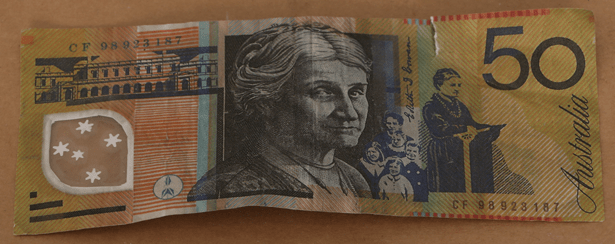
Benjamin Gilette-Rothschild, a 34 year old Sydney man, has pleaded guilty to producing $1m in counterfeit $50 notes, on what appears to be a cheap printer with UV inks and some plastic sheeting.
Gillette-Rothschild used fake companies and names to buy three commercial printers for $80,000, along with more than $10,000 worth of UV inks, and 196kg of propylene film, between the end of 2013 and mid 2014.
The court has made a suppression order on most details of the case, including the equipment used and how the defendant produced the fake notes for now. Gillette-Rothschild, who apparently had no print training, pled guilty to eight charges relating to counterfeit production.
Three years after the fake notes were made, authorities have seized back $850,000 worth, leaving $150,000 worth of $50 notes still in circulation.
Court documents showed an analysis from the Reserve Bank of Australia (RBA), who said the fake notes were high-quality and could only be produced using specialised equipment and specific skills and knowledge. The fake banknotes were also said to be potentially not detected as counterfeit by the general public, even with close inspection.
Gillette-Rothschild established the scheme with a commercial printer purchased for $10,000 from a Hornsby company at the end of 2013, before using a fake name to buy a second machine for $24,000 from a business in North Rocks. Two weeks later, he traded in both printers and paid an additional $33,000 for a superior machine.
He said it was so easy he spent most of his time relaxing in his leather chair while the machine pumped out the fake notes.
The counterfeiter was only caught because a salesman was cleaning out one of the traded in machines a clear plastic sheet with an image of an Australian banknote fell out. The authorities were notified and the Australian Federal Police commenced an investigation in March, 2015 after being referred by the RBA.
Between May and June 2014, Gillette-Rothschild bought more than $12,000 worth of UV inks from a printing company in Rhodes, along with 196kg of polypropylene film from a national supplier between April and June 2014, according to court documents.
[Related: Canadian Mint sues Aus over colour printing]
After printing the $50 notes between March and July in 2014, court documents say Gillette-Rothschild had four Korean nationals flown to Sydney, where each received a suitcase holding up to $100,000 in counterfeit notes and were told to get change at retail stores.
While Gillette-Rothschild’s printing process or equipment has not been revealed, another man in Sydney, Agapitos Megaloudis, was arrested for using three Roland DG printers in 2009 to print counterfeit $50 notes. Megaloudis and his brother were discovered with what was said to be enough polymer to make notes with a nominal value of more than $40m.
Police intercepted a call between Gillette-Rothschild and co-accused, Danqing Xu in March 2016. The two were said to have an earlier conversation in 2014 where Gillette-Rothschild claimed being the cause of the RBA making changes to Australian notes. He asked one associate if he would be interested in overlooking the printing while he slept, and asked another person if he would be interested in working 12 hour shifts, with an aim to have the operation running 24 hours a day.
Gillette-Rothschild was arrested on September 2, 2016, during a raid. Xu received a 12 month suspended jail sentence in October last year for his involvement.
According to the RBA, around 20,749 or $1.03m worth of counterfeit $50 notes were detected in the 2016-2017 financial year. In that period, the RBA detected 25,491 fake notes in total, with a nominal value of $1.47m. Fake $50 notes were the most widely circulated, covering 80 per cent of all counterfeits detected in the previous financial year.
A report from the RBA shows Australia was one of four countries where counterfeit rates rose in 2015.
A new $50 note with updated security features is set to be released from the Reserve Bank of Australia in October, following the new $5 and $10 notes that have come out in the past two years. The RBA will not comment on whether the introduction of the new notes was as a consequence of this counterfeiting attempt.
Judge Gary Neilson of the Downing Centre District Court gave Gillette-Rothschild an undisclosed sentence, details to be revealed when the case is finally wound up.
Comment below to have your say on this story.
If you have a news story or tip-off, get in touch at editorial@sprinter.com.au.
Sign up to the Sprinter newsletter

